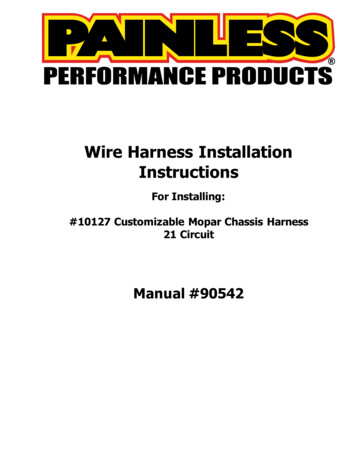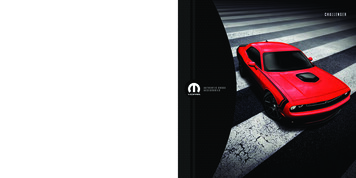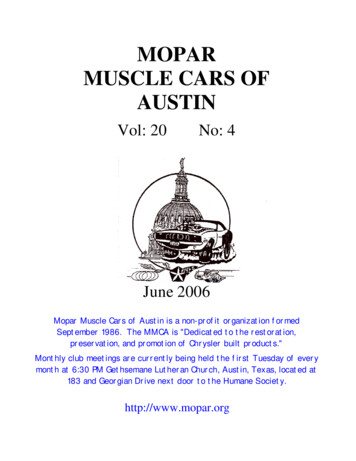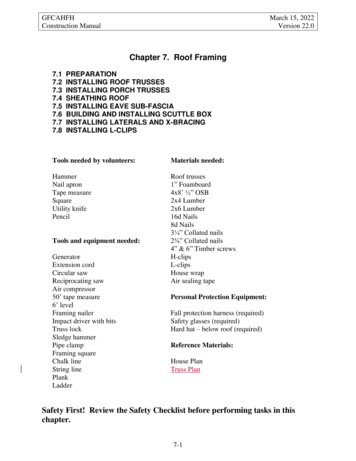
Transcription
Wire Harness InstallationInstructionsFor Installing:#10127 Customizable Mopar Chassis Harness21 CircuitManual #90542
Painless Performance Products, LLC2501 Ludelle StreetFort Worth, TX 76105-1036800-423-9696 phone – 817-244-4024 faxWeb Site: www.painlessperformance.comE-Mail: painless@painlessperformance.comIf you have any questions concerning the installation of this product, feelfree to call Painless Performance Products' tech line at 1-800-423-9696. Callsare answered from 8am to 5pm central time, Monday thru Thursday, 8am4:30pm Friday, except holidays.Here we have provided you with accurate instructions for the installation ofthis product. However, if you have comments/suggestions concerning theseinstructions, please call or email us (our contact information can be found at thetop of this page or online at www.painlessperformance.com).We sincerelyappreciate your business.Painless Performance Products, LLC shall in no event be liable incontract or tort (including negligence) for special, indirect, incidental, orconsequential damages, such as but not limited to, loss of property, or any otherdamages, costs or expenses which might be claimed as the result of the use orfailure of the goods sold hereby, except only the cost of repair or replacement.Should you damage or lose part of your manual, a full color copy of theseinstructions can be found online at www.painlessperformance.comInstallation Manual: 905421ST Edition: January 13, 2014Copyright 2005 by Painless Performance Products, LLCTABLE OF CONTENTS
igureFigureFigureList of Figures List of Tables .List of Diagrams .i44Introduction .About These Instructions .Contents Of The Painless Wire Harness Kit .Tools Needed .Pre-Installation and General Harness Routing Guidelines .Harness General Installation Instructions .6.1Rough Installation .6.2Harness Attachment .6.3Grounding the Automobile .6.4Terminal Installation and Making Connections .6.5Testing the System .Mopar - Specific Circuit Connections .7.1Mopar Alternator 7.2Mopar Ignition System 7.3Steering Column Wiring - Turn Signal Connections .7.4Steering Column Wiring - Ignition Switch Connections .All Makes - Specific Circuit Connections 8.1Generator Charging System .8.2Generator to Alternator Conversion .8.3Connecting to Ammeter and the Maxi-Fuse .8.4Interior Lighting . 8.5Headlight Section "A" .8.6Headlight Section "B" .8.7Instrument Panel Wiring .8.8Brake Light Switch 8.9Tail Section Wiring 8.10 Helpful Hints for Tail Section Wiring .Wire Connection Index . 455667778889991212131313141415161616171819LIST OF FIGURESPainless Harness Kt .Mopar Alternator High Output Wire .Mopar Ignition System Mopar Electronic Ignition with Dual Ballast Resistor Turn Signal Terminal Generator Charging System .Ammeter and Maxi-Fuse Interior Lighting .Typical Fan Relay Installation .Headlight Section "A" Wiring .Dual Head Lamp Connections Dimmer Switches .Integrated Brake Light and . .Separate Turn/Brake Lights 8.18.28.38.4A8.4B8.5A8.5B8.7A8.7bFigure 8.10A Lamp Socket Terminal . 18
Figure 8.10B Lamp Socket Assembly . 18LIST OF TABLESTable 7-1Table 9-1Table 9-1Mopar Ignition and Turn Signal Wiring Wire Connection Index (1 of 2) Wire Connection Index (2 of 2) 122021LIST OF DIAGRAMSDiagram 1Diagram 21.0Instrument Panel Section Wiring .Engine Wiring .2223INTRODUCTIONYou have purchased what we at Painless Performance Products believe to be the most up -to-date and easiest-toinstall automotive wire harness on the market. It is designed for easy installation, even if you have no electricalexperience.All kits have a built-in-anti-theft feature. Removing the fuse labeled "coil" from the fuse block will prevent the vehiclefrom starting.The proper fuses have been pre-installed in the fuse block. In addition, all wires are color-coded. This will help youidentify the different circuits during installation and later on if additions to the overall system are necessary. For fusespecifications and wire color designations, see Section 9.0.All wire is 600 volt, 125 c, TXL. Standard automotive wire is GPT, 300 volt, 80 c, with PVC insulation.This complete automobile wiring system has been designed with three major groups incorporated into it:ENGINE/HEADLIGHT GROUPIncludes high beam, low beam, park, right turn, left turn, electric fan, horn, starter solenoid and battery feed,alternator and alternator exciter wire, distributor, water temperature, oil pressure, and air conditioning.DASH GROUPIncludes wires to connect gauges, indicator lights, and switches to their proper sources.REAR LIGHT GROUPIncludes tail lights, dome lights (see Paragraph 8.4.2), left and right turn signals, brake lights, and fuel sender.Installation requires four (4) easy steps:1. Mount the fuse block2. Route the wires3. Cut off the excess wire4. Terminate the wires4
2.0ABOUT THESE INSTRUCTIONSThe contents of these instructions are divided into major Sections, as ut These InstructionsContents of Painless Wire Harness KitTools NeededPre-Installation and General Harness Routing GuidelinesGeneral Harness Installation InstructionsMopar - Specific Circuit Connection DetailsAll Makes - Specific Circuit Connection DetailsWire Connection Index and Fuse RequirementsSections are divided into subsections and Paragraphs. Throughout these instructions, the Figure numbers refer toillustrations and the Table numbers refer to information in table form. These are located in Sections or Paragraphscorresponding to the number. Always pay special and careful attention to any Notes, especially those in the Tables,and any text marked Caution .3.0CONTENTS OF THE PAINLESS WIRE HARNESS KITRefer to Figure 3-1 to take inventory. See that you have everything you're supposed to have in this kit. If anythingis missing, contact the dealer where you obtained the kit or Painless Performance at (800) 423-9696. The PainlessWire Harness Kit should contain the following items:ABCDEFGThe Main Wire Harness, with the Fuse Block wired in and fuses installed.Headlamp Connector Cables. (Extra Headlamp Cables are a vailable separately under P/N 80300.)Maxi FuseFirewall Grommet (large)2 Fender Well Grommets (for Headlamps)2 packages of Nylon Tie WrapsParts Box, containing Terminals, Splices, etc. This booklet, P/N 905 42 Painless Wiring Manual.Figure 3-1 Painless Wire Harness Kit5
4.0TOOLS NEEDEDIn addition to your regular tools, you will need, at least, the following tools:Crimping Tool Note: Use a quality tool to avoid over-crimping.Wire StripperTest Light or Volt MeterElectric Drill1-1/4" Hole SawSmall (10 amp or less) Battery Charger5.0PRE-INSTALLATION AND GENERAL HARNESS ROUTING GUIDELINESThe installation of your wire harness mainly consists in two parts: The physical routing and securing of the wire harness, wires, and groups.The proper connection of the individual circuits.These two major tasks are not separate steps, but are integrated together. That is, you will route some wires andmake some connections, route some more wire and make some more connections.We cannot tell you how to physically route the harness in your automobile. That depends a great deal upon theparticular make/model of automobile and to what extent you want to secure and conceal the harness. We do offersome general guidelines and routing practices starting in Section 5.2, GENERAL installation instructions in Section6.0, and precise instructions concerning the electrical connections you will have to make in beginning in Section7.0. To help you begin thinking through the installation of your wire harness, read the following sections:5.1Familiarize yourself with the harness by locating each of the harness sections in the following list.(Whenever a particular harness section is referred to in these instructions it is shown "all caps": ENGINESECTION A)ACCESSORY SECTION SWITCHESACCESSORY SECTION B DIMMER SWITCH SECTIONENGINE SECTIONENGINE SECTION A (Single, 10 ga. red wire)ENGINE SECTION ATAIL SECTIONPANEL LIGHT SECTIONNote:5.25.3TURN SIGNAL SECTIONHEADLIGHT SECTION AHEADLIGHT SECTION BIGNITION SWITCH SECTIONINSTRUMENT PANEL SECTIONRADIO SECTIONHAZARD SWITCH SECTIONFor complete information concerning the individual circuits and wires that make up the harnessSECTIONS, see Section 9.0.Decide where the fuse block will be mounted. The Painless Wire Harness is designed for the fuse block to bemounted on the driver's side, under the dash.Decide which of the following circuits you will be using in your system and where the harness groups orwires will be routed:ROUTING LOCATION AND PLACEMENTEmergency FlashersHornDome LightsLightsAir ConditionerElectric Cooling FanCoilTurn SignalsRadio Ignition Switched PowerRadio Constant PowerGaugesAccessories6
5.4Where will the following harness groups be routed?HeadlightsEngineDashTail Lights5.55.65.75.85.96.0A good exercise is to lay out the wire harness on the floor beside your automobile and identify all theSECTIONS. You will want to route the harness through and around open areas. Inside edges provi deprotection from hazards and also provide places for tie wraps, clips and other support.Route the harness away from sharp edges, exhaust pipes, and hood, trunk and door hinges.Plan where harness supports will be located. Allow enough slack at places wh ere movement could occur(body to frame, frame to engine, etc.). Use a support every 12 inches unless the harness routes under thefloor carpet.At wire ends don't depend on the terminals to support the harness. The weight of the harness could causeterminals to disconnect or copper wire strands to break.The wires should be bundled into groups. Use nylon ties, poly split loom, or tape.HARNESS GENERAL INSTALLATION INSTRUCTIONS6.1Rough InstallationCAUTION:DISCONNECT THE POWER FROM YOUR VEHICLE BY REMOVING THE NEGATIVE(BLACK) BATTERY CABLE FROM THE BATTERY.Note:Make no wire connections or permanent mounting of any kind at this time!6.1.16.1.2Position the fuse block in its mounting area.Either use the included plate to cover the existing bulkhead hole or d rill a 1-1/4" (1.25") hole nearthe fuse block for engine and headlight group wires to pass through (ENGINE SECTION, ENGINESECTION A, SINGLE 10 GA. (Red wire #916), and HEADLIGHT SECTION A). If using the plate,install it on the “engine side” of the fire wall using the self tapping screws provided.Install the Firewall grommet in the plate or the new hole you drilled. Route engine and headlightgroup wires through the grommet and position the harness groups in the areas decided upon inSections 5.3 and 5.1.Route dash group (ACCESSORY SECTION B , ACCESSORY SECTION SWITCHES, HEADLIGHTSECTION B, INSTRUMENT PANEL SECTION and RADIO SECTION) upward to rear of dash andtemporarily tie in place.Position rear group, consisting of theTAIL SECTION, on floor pan area decided upon in Sections5.3 and 5.4.6.1.36.1.46.1.56.2Harness AttachmentNote: Harness routing and shaping is and should be a time-consuming task. Taking your time willenhance the beauty of your installation. Please be patient and TAKE YOUR TIME!6.2.16.2.26.2.3Permanently mount the fuse block base with 2 self tapping screws supplied with this kit. (Note:The fuse block itself does not have to be grounded.)Mold harness groups to the contour of floor pan, firewall, fender panels, and any other area wherewires or harness groups are routed. Remember to route the harness away from sharp edges,exhaust pipes, hood, trunk and door hinges, etc.Attach harness groups to your automobile with clips or ties starting at the fuse block and workingtoward the rubber grommet for the front groups a nd along the floor pan for the rear group. Thedash wires should be routed out of the way of any under-dash obstacles, such as cowl vent, airconditioning, radio, etc.Note: Do not tighten tie wraps and mounting devices at this time. Make all harness attachmentsLOOSELY.6.2.4When used every 1-1/2" or so on the visible areas of the harness, the plastic wire ties make a veryattractive assembly. A tie installed in other areas every 6" or so will hold the wires in place nicely.Remember to take your time!7
6.3Grounding the AutomobileA perfectly and beautifully wired automobile will nevertheless have bugs and problems if everything is notproperly grounded. Do not go to the careful effort of installing a quality wire harness only to neglect propergrounding.Note: The Painless Wire Harness Kit includes no ground wire except the black wire from the twoheadlamp connectors. You must supply ground wire (14 -16 gauge) for all circuits.6.3.16.3.26.3.36.3.46.4Connect a Ground Strap or Cable (minimum of 2 gauge) from the Negative Battery terminal to theengine block.Connect a Ground Strap from the Engine to the chassis. DO NOT RELY UPON THE MOTORMOUNTS TO MAKE THIS CONNECTION.Connect a Ground Strap from the Engine to the Body.If you have a fiberglass body you should install a terminal block to ground all your Gauges andAccessories. Ground the Terminal Block with at least a 12 -gauge wire to the chassis.Terminal Installation and Making ConnectionsNote: In the following steps you will be making the circuit connections. Before you start, you shouldcarefully read Sections 7.0 through 8.0, as appropriate, and continually refer to Section 9.0, DOUBLECHECKING your routing and length calculations before cutting any wires and making connections. Givespecial attention to Turn Signal and Ignition Switch connections. These can be somewhat confusing.6.4.16.4.26.4.36.4.4Have all needed tools and connectors handy.Select the correct size terminal for the wire and stud application.Determine the correct wire length and cut the wire. Remember to allow enough slack in theharness and wires at places where movement could possibly occur, such as automobile body toframe, frame to engine, etc. Double-check your calculations.Strip insulation away from wire. Strip only enough necessary for the type of terminal lug you areusing.Note: In the following step, make sure that the terminal is crimped with the proper die in the crimpingtool. An improper crimp will NOT make a good connection.6.4.5Crimp the terminal onto the wire.CAUTION:6.4.66.4.76.5DO NOT OVER-CRIMP!Connecting the harness throughout the groups is a redundant process. Make sure that each wire isFIRST properly routed and THEN attach. DO NOT ATTACH FIRST THEN ROUTE AFTERWARD.When all wires are attached, tighten the mounts and ties to secure harness permanently.Testing The System6.5.1Use a small (10 amp or less) battery charger to power up the vehicle for circuit testing. If there is aproblem anywhere, the battery charger's low amperage and internal circuit breaker will providecircuit protection.CAUTION:IF YOU HAVE NOT YET DISCONNECTED THE BATTERY FROM THE AUTOMOBILE,DO SO NOW! DO NOT CONNECT THE BATTERY CHARGER WITH THE BATTERY CONNECTED.Connect the battery charger's NEGATIVE output to the automobile chassis or engine block and itsPOSITIVE output to the automobile's positive battery terminal.6.5.2INDIVIDUALLY turn on each light, ignition, wiper circuit, etc. and check for proper operation.Note: The turn signals will not flash properly if you do not have both the front and rear bulbs installedand connected.6.5.3When all circuits check out THEN attach the battery cable to the battery for vehicle operation.8
7MOPAR - SPECIFIC CIRCUIT CONNECTIONS7.1Mopar Alternator. See Figure 9-1Note: Your Alternator may not appear exactly as represented in Figure 7-1. The circuits are wired thesame way, though.7.1.17.1.2Mopar uses one of two kinds of voltage regulators: An electronic regulator and a mechanical one.The electronic voltage regulator is represented in Figure 7-1A. It does not matter how the twoterminals are connected, so long as they are BOTH connected. The mechanical regulator hasterminals marked "F" (Field) and "l" (Ignition). In contrast to the electronic regulator, it DOESmake a difference how the mechanical regulator is connected.Connect ENGINE SECTION wire #914 (BLU) to the Alternator Field (F) terminal as shown in Figure7-1A. Connect ENGINE SECTION wire #915 (BLK) to the Alternator Output lug (Bat).CAUTION:IF USING AN ALTERNATOR WITH AN OUTPUT LARGER THAN 65 AMPS,YOU WILL ALSO NEED TO USE JUMPER WIRE #960 (RED), INCLUDED IN BOX. THEWIRE END WITH THE RING TERMINAL AND RUBBER BOOT WILL CONNECT TO THEALTERNATOR OUTPUT LUG. ROUTE THE OTHER END TO THE STARTER. CUT THE WIREAND CRIMP ON A RING TERMINAL. INSTALL ON SAME TERMINAL OF MAXI FUSE AS#916 RED. SEE FIGURE 7-1B.7.1.37.1.47.1.5Connect a 14-gauge wire from the Alternator terminal where wire #914 is connected to either ofthe ELECTRONIC Voltage Regulator terminals OR terminal (l) of the MECHANICAL VoltageRegulator. On existing Mopar harnesses, this would be a blue wire.Connect a 14-gauge wire from the other Alternator Field terminal (as shown in Figure 7-1) to thesecond terminal of the ELECTRONIC Voltage Regulator OR terminal (F) of the MECHANICALVoltage Regulator. On existing Mopar harnesses, this would be a green wire.Finally, be sure BOTH the alternator and the voltage regulator itself are grounded.Figure 7-1A Mopar Alternator7.2Mopar Ignition (Start/Run) System. See Figure 7-2ANote:If you are going to install an ammeter, see Section 8.3 first.7.2.1Connect ENGINE SECTION (single) 10-gauge red wire #916 (with or without ammeter) to theMAXI fuse. Use remaining 10 ga. to connect to Starter Relay Battery Terminal. Retain excess wire.9
Figure 7-1B High Output Wire7.2.27.2.37.2.47.2.57.2.67.2.7With crimping tool, attach the Maxi Fuse onto remaining length of red 10 -gauge wire. It serves asa fuse to protect the entire harness. DO NOT OMIT IT! Connect this wire from th e Starter MotorBattery terminal, as shown in Figure 7-2A. USE ONLY 10-GAUGE WIRE or LARGER.Connect ENGINE SECTION A wire #919 (YLW) to the Starter Relay Ignition (l) terminal.Connect a 14-gauge wire from the Starter Relay Ground (G) terminal to the center terminal of thetransmission mounted Neutral Safety Switch. Older Mopar neutral safety switches have only oneterminal. On newer switches, the two outside terminals are for backup lights (see Figure 7-2A).If the Neutral Safety Switch is mounted in the floor shifter, connect the Starter Relay Ground (G)terminal to chassis ground. Refer to Paragraph 7.4.2 to wire the Neutral Safety Switch.If you are using the Ballast Resistor, mount it away from other wiring or hoses. The ballast resistorgets very hot during operation. Connect ENGINE SECTION A wire #931 (BRN) to one end of theBallast Resistor. Connect the other end of the ballast resistor to the Ignition Coil POSITIVE ( )terminal with 14-gauge wire (you may have enough BROWN wire left over to accomplish this). Ifyou are not using a Ballast Resistor, connect wire #9 31 directly to the Ignition Coil B terminal.Wire #920 (BLU) will connect to the other side of the ballast resistor. Figure 7-2AThe Ignition Coil NEGATIVE (-) terminal is connected to the Distributor. Also connect ENGINESECTION A wire #923 (GRY/BLK) to the Ignition Coil NEGATIVE (-) terminal. This is thetachometer source. If you are not using a tachometer, insulate and stow wire #923.If using a Mopar Electronic Ignition, the Black/yellow wire from the module will also connect to thenegative side of the coil.7.2.8Be sure the large, red battery cable is connected from the Battery to the Starter Motor Batteryterminal (the same place the Maxi Fuse is connected).7.2.9If using a Mopar Dual ballast resistor, see Figure 7-2B.10
Figure 7-2A Mopar Ignition (Start/Run) SystemFigure 7-2B Mopar Electronic Ignition with Dual Ballast Resistor11
7.3 Steering Column Wiring - Turn Signal ConnectionsRefer to Table 7-1. Check your existing wiring (by tracing the wire, if necessary) against the data given.7.3.1 According to Table 7-1, connect the wires of the TURN SIGNAL SECTION using the suppliedterminals (see Figure 7.3) to your automobile's existing Turn Signal Connector. Mopar wire color codes fora number of years are provided for reference. Mopar has not been uniform in assigning wire colors over theyears; so you may find that the wire colors in your existing Mopar harness differ from those shown.Figure 7.3 Turn Signal Connector Terminal7.3.2If there is any doubt, be on the safe side. Trace the wire(s) with an ohmmeter, circuit tester, ortest light. DON'T GUESS!Note: Disconnect one end of the wire you are tracing. If you leave it connected, there is apossibility of tracing it back through some other circuit and getting false results.7.3.3If your existing Turn Signal Connector requires a Horn Ground wire, install one. The TURN SIGNALSECTION has no ground wire, nor does it support s eat belt buzzers, or key alarms.If your using an aftermarket column which requires GM turn signal connectors, you’ ll need Painlesspart #30806.7.4 Steering Column Wiring - Ignition Switch Connections7.4.17.4.27.4.3Connect the wires of the IGNITION SWITCH SECTION according to Table 7-1.IGNITION SWITCH SECTION wire #919 (YLW) is to be connected to a Neutral Safety Switch.However, Mopar switches are mounted in the transmission. The transmission-mounted neutralsafety switch was wired at Paragraph 7.2.4. FOR SAFETY, PLEASE USE A NEUTRAL SAFETYSWITCH!If the neutral safety switch is mounted on a floor shifter, see note 7 in wire connection index.1970-74 WITHOUT TILT COLUMNTURN SIGNAL CONNECTORMoparColorDesignationPainlessWire No.PainlessColorWhtTanGrnBrnGrnBlkRedBlkStop Light SwitchRF Turn SignalLF Turn SignalRR Turn SignalLR Turn SignalHazard FlasherTurn GrnBlkRedBlk919931932933934YlwBrnBlkBluRedIGNITION SWITCH CONNECTORYlw¹BrnBlkBluRedIgnition StartIgnition CoilAccessory Fuse PanelIgnition Switched Fuse PanelBattery B NOTES:1.12 gauge wireTable 7-1 Mopar Ignition and Turn Signal Wiring12
8ALL MAKES - SPECIFIC CIRCUIT CONNECTIONS8.1Generator Charging System. See Figure 8-1.8.1.18.1.28.1.38.1.4Connect Generator ARMATURE terminal (A) to Voltage Regulator terminal A. Connect GeneratorFIELD terminal (F) to Voltage Regulator terminal F. Use 14-gauge wire (color optional) for FIELDand 12-gauge wire for Armature.Be sure both the generator and the voltage regulator are securely grounded. The voltage regulatormay have a terminal for this purpose (labeled "G") or you may have to ground the regulator case.Connect ENGINE SECTION wire #915 (BLK) to Voltage Regulator terminal B.Insulate and stow ENGINE SECTION wire #914 (BLU).Figure 8-1 Generator Charging System8.2Generator to Alternator Conversion8.2.18.2.28.2.3You may be able to convert your generator charging system to use an alternator and externalregulator without altering or re-routing existing wires.Install the new alternator and replace the existing generator voltage regulator with the new,alternator compatible one.Connect the existing wiring according to 7.1Figure 8-2 Ammeter & Maxi Fuse13
8.3Connecting an Ammeter and the Maxi Fuse. See Figure 8-2.8.3.1 Most, but not all Ammeters must be inserted IN SERIES onto the ENGINE SECTION (single) 10 gauge wire #916 (red) that routes from the Fuse Panel to Maxi Fuse (Section 7.2).8.3.28.3.38.3.6The overall physical length of this circuit should be as short as possible (allow some slack,however). You may have to cut wire #916 and you may have to add some additional length of 10 gauge wire. USE ONLY 10-GAUGE WIRE OR LARGER.Route wire #916 (from the Fuse Panel) and connect to the Ammeter NEGATIVE terminal. Tocomplete the installation, follow ONE of the next three (3) paragraphs, as appropriate.If you are using a Mopar starter with a starter relay, ro ute the remainder of wire #916 from theAmmeter POSITIVE terminal to the Maxi Fuse terminal. Connect the other side of the Maxi Fuse tothe Starter Solenoid Battery (B ) terminal.CAUTION:BOTH AMMETER TERMINALS MUST ABSOLUTELY BE ISOLATED FROMGROUND. IF EITHER AMMETER TERMINAL COMES IN CONTACT WITH GROUND AHARNESS FIRE IS INEVITABLE. USE EXTREME CARE AND DILIGENCE IN CONNECTINGAMMETERS.CAUTION:BE SURE YOUR AMMETER'S CURRENT (AMPS) RATING EXCEEDS THECURRENT OUTPUT OF YOUR ALTERNATOR. PERFECT PERFORMANCE PRODUCTS, LLCDOES NOT RECOMMEND USING ANY AMMETER RATED AT LESS THAN 65 AMPS. DONOT USE AN AMMETER WITH ANY HIGH OUTPUT ALTERNATOR (MORE THAN 65AMPS).Figure 8-3 Interior Lighting8.4 Interior Lighting. See Figure 8-38.4.18.4.2Interior Lights are switched through the door switches and the dash panel light switch. Theseswitches apply ground to the circuit. YOU WILL NEED TO SUPPLY THESE GROUND WIRES. 12V iscontinually present at the light bulbs. See Figure 8-3.If possible leave your existing interior light wiring intact. The Painless harness supplies the 12Vfeed (B ) to the circuit via TAIL SECTION wire #945 (PNK) and a ground via TAIL SECTIO/ PANELLIGHT SECTION N wire #961 (YLW). For termination, see 8.10.3.14
Figure 8-4A Typical Fan Relay Installation (Painless Part #30101)Figure 8-4B HEADLIGHT SECTION A Wiring8.5 HEADLIGHT SECTION A. See Figure 8-4B.8.5.18.5.2Connect HEADLIGHT SECTION A wire #924 (GRN/RED) to the Horn's hot terminal. TURN SIGNALSECTION wire #963 (BLK) was connected in the Turn Signal Connector section of theseinstructions. The Horn Relay is pre-wired into the Fuse Panel.Connect HEADLIGHT SECTION A wires #908 (RED) to the GREEN and #909 (PPL/BLK) to the TANwires of BOTH Headlamp Connectors. For models with separate high beam head lamps, extra headlamp connectors have been supplied. To make connections for separate high beam lamps, run ajumper wire from the connection of wire #908 (RED) and the GREEN wire from the suppliedconnector, to the GREEN wire of the high beam headlamp connector (see Figure 8.5 A). The TANwire of the high beam headlamp connector is not used. Connect the black wires of the HeadlampConnectors to Chassis Ground. You should have enough wire to accomplish this. You have beensupplied with two small grommets (Figure 3-1) should you need to pass these wires through afender well. Don't forget to thread them onto the wires BEFORE you connect the wires.15
Figure 8.5A Dual Headlamp Connections8.5.38.5.4Connect HEADLIGHT SECTION A wires #927 (BLK/YLW) to ALL front Park Lights and wires# 927(GRN/BLK) to both Marker Lights. Connect HEADLIGHT SECTION A wires #925 (TAN) to theRIGHT FRONT Turn Signal(s). Connect wires #926 (GRN/RED) to the LEFT FRONT Turn Signal(s).Note: Don't confuse Park Lights or Marker Lights with Turn Signals. For termination, see 8.10.3Connect HEADLIGHT SECTION A wire #901 (GRY/WHT) to the Electric Fan Relay. This wire is anactivation wire for the relay, NOT A POWER FEED. The other end of wire #901 is in theACCESSORY SECTION SWITCHES and should be connected to a electric fan switch in the dash.Connect 906 (GRY/WHT) from ACCESSORY SECTION B to the other side of the fan switch.Figure 8-4A shows a typical fan relay installation.Note: The wire going to the fan in Figure 8-4B will be coming from the fan relay output terminal.Wire #901 (GRY/WHT) from the ACCESSORY SECTION SWITCHES is an activation wire for the fanrelay.8.5.5NOTE: If you are using a thermostatic switch in the engine to control the ground for the fan relay,you will then connect the 901 (GRY/WHT) from ACCESSORY SECTION SWITCHES directly to the906 (GRY/WHT) from ACCESSORY SECTION B .Connect the DIMMER SWITCH SECTION to your floor-mounted Dimmer Switch or column-mountedDimmer Switch.Figure 8-5B Dimmer Switches (Push Button Style – Painless Part #80150)8.6HEADLIGHT SECTION B, HAZARD SWITCH, PANEL LIGHT Wiring.8.6.1Connect the 5 wires of HEADLIGHT SECTION B, the 4 wires of the HAZARD SWITCH SECTION, the3 wires of the PANEL LIGHT SECTION. You should trace out the wires of your existing harness andconnect the new harness according to Table 9-1. A headlight switch connector and terminals havebeen provided; they are located in their own parts bag.16
8.7Instrument Panel Wiring8.7.18.7.28.5.1Connect the wires of the INSTRUMENT PANEL SECTION as indicated in Table 9-1. Insulate andstow any wires you do not use.Connect a jumper from wire #935 (BLK) to all Gauges' power or “I” terminals. Connect a jumperfrom wire #930 (ORN) to all Gauges' Instrument Lighting terminals. Connect a jumper to allGauges' Ground terminals and connect to Chassis Ground. For termination, see 8.10.3Refer to the diagram on page 24 for the proper connection of the #991 (Blk), #992 (Ylw), and#993 (Ylw/Blk) wires8.8 Brake Light Switch8.8.28.8.3Connect wires #917 (PNK) and #918 (WHT) to the Brake Light Switch wherever it may bemounted. These wires are in ENGINE SECTION AThe Third Brake Light wire is pre-connected on the Switch end. Connect TAIL SE
5.4 Where will the following harness groups be routed? Headlights Engine Dash Tail Lights 5.5 A good exercise is to lay out the wire harness on the floor beside your automobile and identify all the SECTIONS. You will want to route the harness through and around open areas. Inside edges provide










